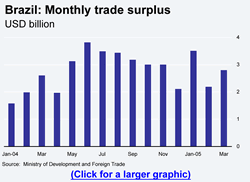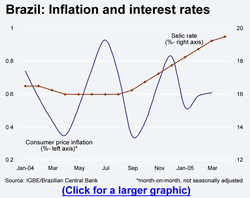BRAZIL: Interest rate poses risk for growth, exports
The Central Bank raised the benchmark Selic rate to 19.5% on April 20. The quarter-point rise, marking the eighth consecutive monthly increase, was unexpected, given the effect of high real interest rates on domestic demand. Exports continue to be the principal motor of growth, despite the appreciation of the real against the dollar.
Analysis
In a context of slowing growth and readjustment of relative prices, the economic model of high fiscal surplus, interest rates and exchange rates will be put to the test in the medium term. However, the trade balance has yet to feel the impact of the appreciation of the real against the dollar:
- As of April 18, the surplus had reached 10.6 billion dollars, with the 1.1 billion dollar surplus in the second week of April representing the best result thus far this year.
- Daily average exports in April have risen by 29.6% year-on-year, while imports have risen by 21.7%.
These figures demonstrate that the appreciation of the real has not caused Brazilian products to lose competitiveness, despite recent warnings by Agriculture Minister Roberto Rodrigues that the effect of the strong exchange rate on agricultural profits could cut the trade surplus by 10% by year-end (see BRAZIL: Less buoyant external results likely in 2005 - February 9, 2005).
As in 2004, the export sector remains the principal motor of growth, given slowing growth in retail sales and industrial output aimed at the domestic market. Domestic sales are not expected to recover significantly in the short term, in particular owing to the series of increases in the Central Bank's benchmark Selic rate. The trade balance will thus continue to be favourable, as lower domestic consumption leaves a significant surplus for export.
Growth. Growth forecasts for this year point to expansion of 3.7%, down from 5.2% in 2004. Existing fiscal policy, predicated on maintenance of a high primary surplus target, has tended to restrict investments in the real economy. Efforts to maintain a competitive exchange rate in order to promote exports have, in turn, been threatened by inflationary pressures, which the Central Bank has sought to control through raising the Selic rate, generating additional pressures on investment in the real economy (see BRAZIL: Interest rates put pressure on real economy - February 17, 2005). In this closed circle, economic expansion is a sub-product: activity rises gradually owing to the multiplying effect of exports on other domestic sectors.
This model generated significant recovery in 2004, but there are increasing doubts as to whether growth can be sustained. This represents a concern given that Brazil needs strong growth, not only to pay high levels of public debt, but also to address social problems. The current model focuses on meeting inflation targets and achieving a high trade surplus, at the expense of strong growth in domestic consumption. However, maintaining inflation targets may prove incompatible with the continuing rise in exports, as the real exchange rate tends to strengthen.
Selic rises. The slowdown in growth, the appreciation of the real and signs that inflation may slow are opening up the possibility of ending the cycle of Selic rate rises which began in September 2004. On April 20, the Central Bank decided a new quarter-point rise, to 19.5%, following a 0.61% increase in March prices which brought twelve-month inflation to 7.5%. Inflation is now expected to end the year at around 6.1%, in comparison with a tar get of 5.1%, and to fall to some 5.0% in 2006. At the same time, the Selic rate is expected to fall from 19.5% at present to 17.5% by the end of 2005.
Signs of slowing growth, reflected in industrial production and retail sales figures, are also expected to discourage further Selic rises. The minutes of the March meeting of the Monetary Policy Committee (Copom) also mentioned as a source of concern the impact of international oil prices and expected US rate rises. Given that oil prices have subsequently eased, and that interest rate rises are unlikely to accelerate in the United States at present, these arguments are likely to carry less weight in deciding the Selic rate in the short term. However, other pending issues could also undermine the current growth model if they remain postponed indefinitely, in particular fiscal, social security and labour reforms.
Financial independence. Since 1998, in the wake of the economic crises in Asia and Russia, Brazil has depended on assistance from the multilateral credit institutions:
- In 1998, the IMF, World Bank, InterAmerican Development Bank (IDB) and the Bank for International Settlements (BIS) lent Brazil 41 billion dollars. Following receipt of the funds, Brazil devalued the real in January 1999.
- In 2001, the IMF again provided a loan of 15 billion dollars.
- In September 2002, the government of President Fernando Henrique Cardoso received a loan of 42.1 billion dollars, the largest ever conceded by the Fund (although Brazil drew down only 26.4 billion). The latter credit was negotiated in consultation with incoming President Luiz Inacio Lula da Silva, who accepted the loan one month before his election, thus committing himself to respect international contracts.
This year Brazil will generate a current account surplus of some 2% of GDP, approximately 25 billion dollars -- virtually the same amount required to meet amortisation of short- and medium-term debt. However, although Brazil did not renew its programme with the IMF (see BRAZIL/ARGENTINA: IMF role sees mixed outcomes - April 1, 2005), and thus gained relative independence from the Fund, it will continue to come under pressure to implement structural reforms.
Financial reforms. Lula has expanded some 'neo-liberal' financial reforms, and raised the possibility of future convertibility for the real, although not during his current term:
- Exchange market liberalisation. In March, the government freed the exchange market almost entirely. The opening, imposed by a Central Bank norm, will facilitate the purchase of dollars and their transfer abroad, by abolishing limits on volume and legal restrictions. Anyone will now be able to buy and transfer dollars or other foreign currencies to other countries, in any amount, with the sole requirement of informing the authorities of the purpose of those transfers. Backed by both the government and Lula's Workers Party, the measure eliminates all controls on capital flows, and aims to attract investment on the assumption that capital will enter the country more freely if it can easily be withdrawn. Initially, this greater freedom of movement of capital will cause a strong inflow of speculative foreign investments, probably further strengthening the real against the dollar.
- Central Bank autonomy. In line with more liberal policies, the government is also expected to renew its efforts to gain congressional approval of plans to grant autonomy to the Central Bank.
Outlook. Until now, Finance Minister Antonio Palocci has opted for increased interest rates to discourage consumption and reduce inflationary pressures. The next phase is economic opening, which will force domestic prices to fall through pressure from external prices. This strategy has already been confirmed by the decision to reduce to zero the tariffs on steel imports. However, the move will have an obvious impact on the trade balance, putting pressure on the high surplus maintained to date.
Conclusion
Despite recent changes in financial regulations, the need to implement other structural reforms, including tax, social security and labour reforms remains key if the current economic model is to continue to perform. Exchange rate pressures and efforts to open the economy are likely to reduce the trade surplus this year.

